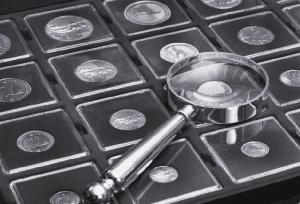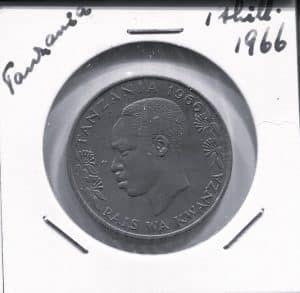Unearthing the Stories behind the 1966 Tanzanian 1 Shilling Coin: A Numismatic Journey 1966 Tanzania 1 Shilling Coin: A Numismatic Journey
In the vast world of numismatics, every coin tells a story. And among the countless coins that have made their way into the annals of history, the 1966 Tanzania 1 Shilling coin stands out. Its humble design carries with it a wealth of historical significance and cultural heritage.
Join us on a captivating journey as we unearth the stories behind this intriguing piece of currency. Delve into the roots of the coin’s design, which encapsulates the spirit of Tanzania’s struggle for independence. Discover the symbolisms and hidden meanings embedded in the coin’s intricate details.
But the journey doesn’t stop there. We’ll take you beyond the aesthetics, exploring the economic and sociopolitical climate that shaped Tanzania during that era. Uncover the social impact this coin had on the lives of Tanzanians, as well as its significance in the broader context of African numismatics.
Whether you’re a seasoned collector, a history enthusiast, or simply curious about the untold tales behind currency, this article is sure to captivate your imagination. Prepare to be transported into the past and gain a deeper appreciation for the rich narratives that can be found within the embrace of a single coin.
Historical context – Tanzania’s independence and currency

Tanzania’s journey to independence was a tumultuous one, marked by resistance against colonial powers and a passionate fight for self-determination. In 1961, Tanganyika gained independence from British colonial rule, becoming the first East African nation to do so. This momentous occasion called for a new national identity, including the creation of a distinct currency.
The 1966 Tanzania 1 Shilling coin was a product of this newfound independence. Its design bore the image of Julius Nyerere, the country’s first president, who played a pivotal role in leading Tanganyika towards independence. The coin became a symbol of pride and a representation of the nation’s aspirations for a brighter future.
As Tanganyika joined with the island of Zanzibar to form the United Republic of Tanzania in 1964, the 1 Shilling coin retained its place in the currency system, now serving a unified nation. This transition further emphasized the historical significance of the coin, solidifying its place in Tanzanian numismatic history.
Design and symbolism of the 1966 Tanzania 1 Shilling Coin
The design of the 1966 Tanzania 1 Shilling coin is a testament to the spirit of independence and the cultural heritage of the nation. On the obverse side, the coin features a portrait of Julius Nyerere, facing left, with the inscription “JULIUS NYERERE” and the year of minting below. The reverse side showcases a traditional African hut, surrounded by the inscription “UNITA – TRAVAIL – PROGRES” which translates to “Unity – Work – Progress” in English.
The image of Julius Nyerere on the coin is a powerful representation of his leadership and the role he played in guiding Tanzania towards independence. It serves as a reminder of the struggles and sacrifices made by the Tanzanian people in their quest for self-rule. The African hut depicted on the reverse side is a nod to the country’s rich cultural heritage and the importance of community in Tanzanian society.
Beyond their aesthetic appeal, the design and symbolism of the 1966 Tanzania 1 Shilling coin evoke a sense of national pride and unity. They serve as a tangible link between Tanzania’s past and present, encapsulating the nation’s values and aspirations.
Rarity and value of the coin
The rarity and value of the 1966 Tanzania 1 Shilling coin vary depending on various factors such as condition, minting errors, and historical significance. As with many coins, the better the condition, the higher its value. Coins that exhibit minting errors or anomalies may also fetch higher prices among collectors who appreciate these unique variations.
In terms of historical significance, the 1966 Tanzania 1 Shilling coin holds immense value for collectors interested in African numismatics and the history of Tanzania’s struggle for independence. Its limited mintage and the fact that it represents an important period in Tanzanian history contribute to its desirability among collectors.
However, it is important to note that the value of a coin is subjective and can fluctuate over time due to market conditions and collector demand. It is always advisable to consult with experts or reputable coin dealers to determine the current market value of the 1966 Tanzania 1 Shilling coin.
Collecting and investing in numismatics

Numismatics, the study and collection of coins, is a fascinating hobby that allows enthusiasts to delve into the rich history and cultural heritage of different nations. Collecting coins can be both an educational and rewarding experience, as each coin offers a unique glimpse into the past.
When it comes to investing in numismatics, it is important to approach it with caution and thorough research. While certain coins may appreciate in value over time, the market can be unpredictable. It is advisable to focus on collecting coins that hold personal significance or appeal to your interests, rather than solely for the purpose of financial gain.
To build a meaningful coin collection, consider exploring different themes, periods, or countries that resonate with you. Joining numismatic societies or attending coin shows and exhibitions can provide opportunities to learn from experts and connect with fellow collectors. Remember that the true value of a coin lies not just in its monetary worth, but also in the stories and history it carries.
Stories and anecdotes associated with the coin
Throughout the years, the 1966 Tanzania 1 Shilling coin has become imbued with stories and anecdotes that add to its allure. Collectors and enthusiasts have shared tales of acquiring the coin during their travels, stumbling upon rare variations, or passing it down as a cherished family heirloom.
One such anecdote involves a collector who discovered a 1966 Tanzania 1 Shilling coin with a minting error. The error resulted in a misalignment of the obverse and reverse sides, making it a unique and valuable find. This unexpected discovery highlighted the importance of paying attention to the finer details when collecting coins.
Other stories revolve around the sentimental value the coin holds for Tanzanians who lived through the struggle for independence. They recall receiving the coin as a symbol of hope and national pride, treasuring it as a reminder of their resilience and the accomplishments of their nation.
These stories and anecdotes contribute to the rich tapestry of numismatics, reminding us that every coin has a story waiting to be discovered.
The importance of preserving numismatic history
Preserving numismatic history is essential for future generations to understand and appreciate the cultural, social, and economic aspects of different periods. Coins provide tangible connections to the past, allowing us to explore the stories and events that shaped societies.
Museums, historical societies, and collectors play a vital role in safeguarding numismatic history. Through their efforts, coins are preserved, studied, and shared with the public, ensuring that their stories are not lost to time. Digitization initiatives have also made it possible for more people to access and explore coin collections virtually, further democratizing the study of numismatics.
By preserving numismatic history, we can gain a deeper understanding of our collective heritage and the interconnectedness of different cultures. Coins serve as valuable artifacts that bridge the gap between the past and the present, offering insights into the lives and aspirations of those who came before us.
Where to find the 1966 Tanzania 1 Shilling Coin

Finding the 1966 Tanzania 1 Shilling coin may require some effort and research, especially if you are looking for specific variations or coins in good condition. Here are a few avenues to explore:
- Coin dealers: Reputable coin dealers often have a wide selection of coins, including those from different periods and countries. They can provide guidance and help you find the specific coin you’re looking for.
- Online marketplaces: Platforms such as eBay, Etsy, and specialized numismatic websites offer a vast range of coins for sale. However, exercise caution and ensure you are dealing with trusted sellers.
- Coin shows and exhibitions: Attending coin shows and exhibitions provides opportunities to browse through a variety of coins, interact with experts, and potentially find the 1966 Tanzania 1 Shilling coin.
- Online auctions: Participating in online auctions can be an exciting way to acquire the coin. Keep an eye on reputable auction websites and be prepared to bid competitively.
Remember to conduct thorough research, verify the authenticity of the coin, and consider the condition and historical significance before making a purchase.
Tips for collecting and caring for numismatic treasures
Collecting and caring for numismatic treasures require proper knowledge and attention to detail. Here are some tips to help you along the way:
- Educate yourself: Learn about the history, design, and characteristics of the coins you collect. Research reputable sources, consult experts, and join numismatic societies to expand your knowledge.
- Handle with care: Coins are delicate objects that can be easily damaged. Always handle them with clean hands, avoiding unnecessary touching of the surfaces. Use cotton gloves or coin tweezers when necessary.
- Store properly: Protect your coins from environmental factors such as moisture, extreme temperatures, and exposure to light. Use acid-free coin holders or capsules to prevent damage and deterioration.
- Avoid cleaning coins: Cleaning coins can potentially damage their surfaces and diminish their value. If necessary, consult a professional conservator who specializes in numismatics.
- Document your collection: Keep a detailed inventory of your coins, including their origin, condition, and any relevant historical or personal information. This documentation will help you track your collection’s growth and provide valuable information for future generations.
By following these tips, you can ensure the longevity and preservation of your numismatic treasures.
Conclusion: The enduring legacy of the 1966 Tanzania 1 Shilling Coin
The 1966 Tanzania 1 Shilling coin stands as a testament to the struggles and aspirations of a nation on the path to independence. Its design, symbolism, and stories associated with it make it a captivating piece of currency that transcends its monetary value.
Through the lens of this coin, we gain a deeper appreciation for Tanzania’s rich history and the immense courage displayed by its people. The 1966 Tanzania 1 Shilling coin serves as a tangible link to the past, reminding us of the importance of preserving numismatic history and the stories that can be found within the embrace of a single coin.
As collectors, enthusiasts, and history lovers, we have the privilege and responsibility to carry forward these stories, sharing them with future generations and ensuring that the cultural heritage encapsulated in coins like the 1966 Tanzania 1 Shilling coin continues to inspire and educate.
So, whether you’re inspired to start a coin collection, eager to learn more about Tanzania’s struggle for independence, or simply captivated by the stories behind currency, let the 1966 Tanzania 1 Shilling coin be your guide into a world of numismatic wonders.
For more articles related to Financial Services in Tanzania, click here!

































